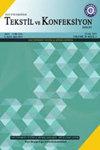Strength and Elasticity Properties of Denim Fabrics Produced from Core Spun Yarns
IF 0.7
4区 工程技术
Q4 MATERIALS SCIENCE, TEXTILES
引用次数: 0
Abstract
In parallel to the development of new fiber and yarn technologies, different fibers and yarns have been used in denim fabric production and breaking the market dominance of 100% cotton yarn in the denim market. In recent years, the use of elastane fibers for denim fabric production has rapidly increased thanks to their movement comfort. This study examines the strength and elasticity properties of denim fabrics containing core yarns. For this purpose, different weft yarns were used in the production of denim fabrics. While 100% cotton ring yarn was used as warp for all fabrics, cotton ring, cotton OE-rotor, cotton / PBT-elastane dual-core, cotton / elastane core and cotton-PET / elastane core yarns were used as weft. Within the scope of the study, tensile strength, tearing strength and bursting strength tests were carried out on denim fabrics. In addition, denim fabrics contain core spun yarns were tested for elasticity in the weft direction, which is the direction of core yarns used. When the results were examined, it was seen that tensile strength and breaking elongation are higher for the fabrics containing core yarn in general. Fabrics produced with dual-core yarns have the highest tearing strength values. In addition, the bursting strength values of fabrics containing core yarn are higher than fabrics without core yarn. It was seen that the elasticity values of denim fabrics produced using core yarn are generally above 50%. However, the highest growth values were seen in the fabrics with the highest elasticity.用包芯纱生产牛仔布织物的强度和弹性
在新纤维和纱线技术不断发展的同时,不同的纤维和纱线被用于牛仔布生产,打破了100%棉纱在牛仔布市场的主导地位。近年来,由于弹性纤维的运动舒适性,其在牛仔布生产中的应用迅速增加。本文研究了含芯纱牛仔布织物的强度和弹性性能。为此,在牛仔织物的生产中使用了不同的纬纱。所有织物的经纱均采用100%纯棉环纱,纬纱采用纯棉环纱、纯棉oe -转子纱、纯棉/ pbt -弹性双芯纱、纯棉/弹性芯纱和纯棉- pet /弹性芯纱。在研究范围内,对牛仔布进行了拉伸强度、撕裂强度和破裂强度试验。另外,对含包芯纱的牛仔布织物在包芯纱使用方向的纬向进行弹性测试。结果表明,含芯纱织物的抗拉强度和断裂伸长率一般较高。用双芯纱生产的织物具有最高的撕裂强度值。此外,含包芯纱织物的破裂强度值高于不含包芯纱织物。结果表明,采用包芯纱生产的牛仔面料弹性值一般在50%以上。然而,在弹性最高的织物中,生长值最高。
本文章由计算机程序翻译,如有差异,请以英文原文为准。
求助全文
约1分钟内获得全文
求助全文
来源期刊

Tekstil Ve Konfeksiyon
工程技术-材料科学:纺织
CiteScore
1.40
自引率
33.30%
发文量
41
审稿时长
>12 weeks
期刊介绍:
Tekstil ve Konfeksiyon, publishes papers on both fundamental and applied research in various branches of apparel and textile technology and allied areas such as production and properties of natural and synthetic fibers, yarns and fabrics, technical textiles, finishing applications, garment technology, analysis, testing, and quality control.
 求助内容:
求助内容: 应助结果提醒方式:
应助结果提醒方式:


